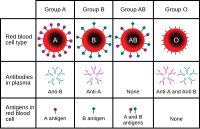
Photo from wikipedia
BACKGROUND PREDICT version 2.0 is increasingly used to estimate prognosis in breast cancer. This study aimed to validate this tool in specific prognostic subgroups in the Netherlands. METHODS All operated… Click to show full abstract
BACKGROUND PREDICT version 2.0 is increasingly used to estimate prognosis in breast cancer. This study aimed to validate this tool in specific prognostic subgroups in the Netherlands. METHODS All operated women with non-metastatic primary invasive breast cancer, diagnosed in 2005, were selected from the nationwide Netherlands Cancer Registry (NCR). Predicted and observed 5- and 10-year overall survival (OS) were compared for the overall cohort, separated by oestrogen receptor (ER) status, and predefined subgroups. A >5% difference was considered as clinically relevant. Discriminatory accuracy and goodness-of-fit were determined using the area under the receiver operating characteristic curve (AUC) and the Chi-squared-test. RESULTS We included 8834 patients. Discriminatory accuracy for 5-year OS was good (AUC 0.80). For ER-positive and ER-negative patients, AUCs were 0.79 and 0.75, respectively. Predicted 5-year OS differed from observed by -1.4% in the entire cohort, -0.7% in ER-positive and -4.9% in ER-negative patients. Five-year OS was accurately predicted in all subgroups. Discriminatory accuracy for 10-year OS was good (AUC 0.78). For ER-positive and ER-negative patients AUCs were 0.78 and 0.76, respectively. Predicted 10-year OS differed from observed by -1.0% in the entire cohort, -0.1% in ER-positive and -5.3 in ER-negative patients. Ten-year OS was overestimated (6.3%) in patients ≥75 years and underestimated (-13.%) in T3 tumours and patients treated with both endocrine therapy and chemotherapy (-6.6%). CONCLUSIONS PREDICT predicts OS reliably in most Dutch breast cancer patients, although results for both 5-year and 10-year OS should be interpreted carefully in ER-negative patients. Furthermore, 10-year OS should be interpreted cautiously in patients ≥75 years, T3 tumours and in patients considering endocrine therapy and chemotherapy.
Journal Title: European journal of cancer
Year Published: 2017
Link to full text (if available)
Share on Social Media: Sign Up to like & get
recommendations!